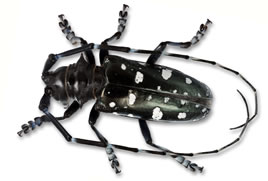Asian longhorned beetle
The Asian longhorned beetle (Anoplophora glabripennis) is native to China and the Korean peninsula.

Asian longhorned beetle (adult).
In Canada, it mainly attacks maple, but also many other tree species such as poplar, birch, willow and elm. It has no natural enemies in Canada and has not been found outside of Ontario.
Quick facts
- Asian longhorned beetle was first identified in Canada, near Toronto, Ontario in 2003. This population was successfully eliminated.
- A second population, discovered near Toronto in August 2013, has also been eradicated.
- The Canadian Forest Service assists the Canadian Food Inspection Agency (CFIA) as well as provincial and municipal governments with eradicating the Asian longhorned beetle.
Impacts
The Asian longhorned beetle can affect ecology, economic activities, urban landscapes as well as tourism and recreation industries.
- The loss of maple trees could affect Canada's multi-million dollar maple syrup industry.
- The loss of hardwoods could affect Canada's forest industry through the loss of billions of dollars in wood products.
- The loss of hardwoods could affect cultural, spiritual and/or economic values of Indigenous people.
- The loss of hardwoods could impact the tourism and recreation industries by affecting tree canopy tourism for “fall-colour tours”.
- The Asian longhorned beetle could have a significant, negative ecological impact if eradication measures are not effective.
CFS scientific research
The Canadian Forest Service (CFS) has learned much about the Asian longhorned beetle under the leadership of its Great Lakes Forestry Centre (GLFC) scientists:
Cross section of a maple tree trunk damaged by Asian longhorned beetle.
- Its life cycle (from egg to emerging adult) lasts from one to three years.
- Adult beetles emerge by chewing their way out of trunk and branches, leaving large round holes (6-14 mm in diameter).
- Adult beetles feed on foliage for a few weeks, female beetles then chew grooves into the bark to lay single eggs that hatch within two weeks.
- Large scale surveys designed to detect signs of damage caused by Asian longhorned beetles are conducted mainly during the winter months, when trees have no leaves.
- GLFC scientists developed and published a comprehensive manual they use as a training guide.
- GLFC scientists have also developed a spatial decision support system used to guide survey operations during activities to eradicate this beetle.
Working collaboratively to develop solutions
Natural Resources Canada, through its Canadian Forest Service, works in collaboration with federal government agencies such as the Canadian Food Inspection Agency (CFIA) and the Canadian Border Security Agency (CBSA), provinces, territories, stakeholders and communities across the country to address ongoing concerns associated with the Asian longhorned beetle.
We work with our partners to continue the successful ongoing proactive monitoring for Asian longhorned beetle in Toronto, as well as across Canada.
Want more information on the Asian longhorned beetle?
Contact Jean Turgeon, Great Lakes Forestry Centre.
- Asian Longhorned Beetle (2011)
- Density and location of simulated signs of injury affect efficacy of ground surveys for Asian longhorned beetle (2010)
- Great Lakes Forestry Centre e-Bulletin (Spring 2010)
- Managing invasive populations of ALB and citrus longhorned beetle (2010)
- Détection des signes et des symptômes d’attaque par le longicone étoilé (2017) [in French only]
- More CFS publications on the Asian longhorned beetle
Page details
- Date modified: